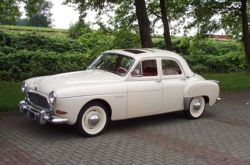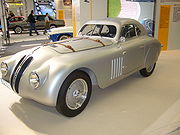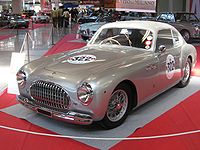
Ponton (automobile)
Encyclopedia


Running board
A running board is a car or truck accessory part, a narrow step fitted under the side doors of the vehicle. It aids entry, especially into high vehicles. Typical of vintage cars which had much higher ground clearances than today's cars, it is also used as a fashion statement on vehicles that would...
s and fully articulated fenders
Fender (vehicle)
Fender is the US English term for the part of an automobile, motorcycle or other vehicle body that frames a wheel well . Its primary purpose is to prevent sand, mud, rocks, liquids, and other road spray from being thrown into the air by the rotating tire. Fenders are typically rigid and can be...
became less common and bodywork began to enclose the full width and uninterrupted length of a car. The trend was also called envelope styling.
The term, which is now largely archaic, especially describes the markedly bulbous, slab-sided configuration of postwar
World War II
World War II, or the Second World War , was a global conflict lasting from 1939 to 1945, involving most of the world's nations—including all of the great powers—eventually forming two opposing military alliances: the Allies and the Axis...
European cars, including those of Mercedes-Benz
Mercedes-Benz
Mercedes-Benz is a German manufacturer of automobiles, buses, coaches, and trucks. Mercedes-Benz is a division of its parent company, Daimler AG...
, Opel
Opel
Adam Opel AG, generally shortened to Opel, is a German automobile company founded by Adam Opel in 1862. Opel has been building automobiles since 1899, and became an Aktiengesellschaft in 1929...
, Auto Union
Auto Union
Auto Union was an amalgamation of four German automobile manufacturers, founded in 1932 and established in 1936 in Chemnitz, Saxony, during the Great Depression. The company has evolved into present day Audi, as a subsidiary of Volkswagen Group....
, DKW
DKW
DKW is a historic German car and motorcycle marque. The name derives from Dampf-Kraft-Wagen .In 1916, the Danish engineer Jørgen Skafte Rasmussen founded a factory in Zschopau, Saxony, Germany, to produce steam fittings. In the same year, he attempted to produce a steam-driven car, called the DKW...
, Borgward
Borgward
Borgward was a German automobile manufacturer founded by Carl F. W. Borgward . The company was based in Bremen...
, Lancia
Lancia
Lancia Automobiles S.p.A. is an Italian automobile manufacturer founded in 1906 by Vincenzo Lancia and which became part of the Fiat Group in 1969. The company has a long history of producing distinctive cars and also has a strong rally heritage. Some modern Lancias are seen as presenting a more...
, Fiat
Fiat
FIAT, an acronym for Fabbrica Italiana Automobili Torino , is an Italian automobile manufacturer, engine manufacturer, financial, and industrial group based in Turin in the Italian region of Piedmont. Fiat was founded in 1899 by a group of investors including Giovanni Agnelli...
, Rover, Renault
Renault
Renault S.A. is a French automaker producing cars, vans, and in the past, autorail vehicles, trucks, tractors, vans and also buses/coaches. Its alliance with Nissan makes it the world's third largest automaker...
and Volvo
Volvo
AB Volvo is a Swedish builder of commercial vehicles, including trucks, buses and construction equipment. Volvo also supplies marine and industrial drive systems, aerospace components and financial services...
— as well as similar designs from North America.
The term derives from the French
French language
French is a Romance language spoken as a first language in France, the Romandy region in Switzerland, Wallonia and Brussels in Belgium, Monaco, the regions of Quebec and Acadia in Canada, and by various communities elsewhere. Second-language speakers of French are distributed throughout many parts...
and German
German language
German is a West Germanic language, related to and classified alongside English and Dutch. With an estimated 90 – 98 million native speakers, German is one of the world's major languages and is the most widely-spoken first language in the European Union....
word Ponton, meaning pontoon. The Langenscheidt
Langenscheidt
Langenscheidt is a privately held German publishing company, specialising in language resource literature. As well as producing monolingual dictionaries, Langenscheidt also produces bilingual dictionaries and travel phrase-books, as well as maps and atlases....
German-English dictionary defines Pontonkarrosserie as "all-enveloping bodywork, straight-through side styling, slab-sided styling.
Origin of the trend

Germany
Germany , officially the Federal Republic of Germany , is a federal parliamentary republic in Europe. The country consists of 16 states while the capital and largest city is Berlin. Germany covers an area of 357,021 km2 and has a largely temperate seasonal climate...
of adding full-length tread armor along each side of a tank, attached primarily on the top edge — which resembled pontoons. As this roughly coincided with automobile styling trend where bodywork, especially running boards and fenders, became less articulated — with cars carrying integrated front fenders and full-width, full-length bodywork — the design took on the "pontoon" or "ponton" descriptor.
One of the first known cars with a ponton body is the Bugatti type 32 "Tank" which participated
in the 1923 French Grand Prix at Tours.
In 1924, Fidelis Böhler designed one of the first production cars with a ponton body, the Hanomag 2/10. The car's body resembled a loaf of bread
Bread
Bread is a staple food prepared by cooking a dough of flour and water and often additional ingredients. Doughs are usually baked, but in some cuisines breads are steamed , fried , or baked on an unoiled frying pan . It may be leavened or unleavened...
earning it the sobriquet
Sobriquet
A sobriquet is a nickname, sometimes assumed, but often given by another. It is usually a familiar name, distinct from a pseudonym assumed as a disguise, but a nickname which is familiar enough such that it can be used in place of a real name without the need of explanation...
of "Kommissbrot
Kommissbrot
Kommissbrot, formerly Kommißbrot, is a dark type of German bread, baked from rye and other flours, historically used for military provisions.-Description:...
" - a coarse whole grain
Whole grain
Whole grains are cereal grains that contain cereal germ, endosperm, and bran, in contrast to refined grains, which retain only the endosperm. Whole grains can generally be sprouted while refined grains generally will not sprout. Whole-meal products are made by grinding whole grains in order to make...
bread as issued by the army. The economical car was produced from 1924 to 1928. Böhler built the core body around two side-by-side passenger seats. He dispensed with running board
Running board
A running board is a car or truck accessory part, a narrow step fitted under the side doors of the vehicle. It aids entry, especially into high vehicles. Typical of vintage cars which had much higher ground clearances than today's cars, it is also used as a fashion statement on vehicles that would...
s and integrated the fenders in the body to save on weight. The cheap car became a best seller in Germany.
In 1935, Vittorio Jano
Vittorio Jano
Vittorio Jano was an Italian automobile designer of Hungarian descent from the 1920s through 1960s.Jano was born Viktor János in San Giorgio Canavese, in Piedmont, to Hungarian immigrants, who arrived there several years before the birth of Jano. He began his career at the car and truck company...
, working with the brothers Gino and Oscar Jankovitz, created a one-off mid-engine prototype on an Alfa Romeo 6C 2300
Alfa Romeo 6C
The Alfa Romeo 6C name was used on road, race and sports cars made between 1925–1954 by Alfa Romeo. 6C refers to a straight 6 engine. Bodies for these cars were made by coachbuilders such as James Young, Zagato, Touring, Castagna, and Pininfarina...
chassis, which Jano had shipped to Fiume, Croatia
Rijeka
Rijeka is the principal seaport and the third largest city in Croatia . It is located on Kvarner Bay, an inlet of the Adriatic Sea and has a population of 128,735 inhabitants...
in 1934. The brothers Jankovitz had been close friends with leading Hungarian aerodynamicist Paul Jaray
Paul Jaray
Paul Jaray , 11 March 1889 Vienna–22 September 1974 St. Gallen, was an engineer and a pioneer of automotive streamlining.-Life:Jaray, of Hungarian-Jewish descent, was born in Vienna...
, and the prototype, called the Alfa Romeo Aerodinamica Spider, featured ponton styling — an especially early and clear example of the bulbous, uninterrupted forms that would come to characterize the genre.
In 1937, Pinin Farina designed a flowing ponton-style body for the Lancia Aprilia
Lancia Aprilia
Lancia Aprilia is automobile manufactured by Lancia, one of the first designed using wind tunnel in collaboration with Battista Farina and Politecnico di Torino, achieving a record low drag coefficient of 0.47....
berlinetta aerodynamica coupé, and also the open body on the 1940 Lancia Aprilia Cabriolet.


Cisitalia
Cisitalia was an Italian sports and racing car constructor. The name "Cisitalia" derives from "Compagnia Industriale Sportive Italia", a business conglomerate founded in Turin in 1946 and controlled by the wealthy industrialist and sportsman Piero Dusio...
202 coupé, which Farina designed from sketches by Cisitalia’s Giovanni Savonuzzi, was the car that "transformed postwar automobile design" according to New York’s Museum of Modern Art
Museum of Modern Art
The Museum of Modern Art is an art museum in Midtown Manhattan in New York City, on 53rd Street, between Fifth and Sixth Avenues. It has been important in developing and collecting modernist art, and is often identified as the most influential museum of modern art in the world...
(MoMA). MoMA acquired an example for its permanent collection in 1951, noting that the car’s "hood, body, fenders, and headlights are integral to the continuously flowing surface, rather than added on. Before the Cisitalia, the prevailing approach followed by automobile designers when defining a volume and shaping the shell of an automobile was to treat each part of the body as a separate, distinct element." Also introduced in 1947, the Alfa Romeo 6C 2500 was another ponton-style Farina design which, together with those by Touring
Touring
Touring may mean:* touring, the estate/wagon version of BMW cars* Bicycle touring* Ski touring* Touring * Carrozzeria Touring* Touring * Touring car racing* a model of Hymer campers* a song by The Ramones* Touring theatre...
and others on the same chassis, has also been credited with setting the trend for post-war automotive design.
Rounded, flowing forms, with unbroken horizontal lines between the fenders— the style had identified as "the so-called Ponton Side Design" became "the new fashion in Europe", offered by Alfa-Romeo, Fiat, Rover and other companies.
An inspiration to American and Japanese manufacturers as well as to Europeans, Farina’s "ponton line" would be copied round the world. One of the first American cars to adopt it was the 1947 Studebaker Champion
Studebaker Champion
The Studebaker Champion is an automobile which was produced by the Studebaker Corporation of South Bend, Indiana from the beginning of the 1939 model year until 1958....
, designed by Virgil Exner
Virgil Exner
Virgil Max "Ex" Exner, Sr. was an automobile designer for numerous American companies, notably Chrysler and Studebaker. He is known for his "Forward Look" design on the 1955-1963 Chrysler products and his fondness of fins on cars for both aesthetic and aerodynamic reasons.-Early life:Born in Ann...
and Roy Cole but sometimes erroneously attributed to Raymond Loewy
Raymond Loewy
Raymond Loewy was an industrial designer, and the first to be featured on the cover of Time Magazine, on October 31, 1949. Born in France, he spent most of his professional career in the United States...
. Another, the Howard "Dutch" Darrin-designed 1947-1950 Kaiser-Frazer
Kaiser-Frazer
The Kaiser-Frazer Corporation was the result of a partnership between automobile executive Joseph W. Frazer and industrialist Henry J. Kaiser. In 1947, the company acquired the automotive assets of Graham-Paige, of which Frazer had been president before the Second World War...
, was said to have been the inspiration for the 1949 Borgward Hansa 1500
Borgward Hansa 1500
The Hansa 1500 is a medium sized saloon that was manufactured by the Bremen based auto-manufacturer Carl F. W. Borgward GmbH. The strikingly modern car was presented at the Geneva Motor Show in March 1949...
, Germany's first sedan in the ponton style.
In the Soviet Union the GAZ-M20 Pobeda
GAZ-M20 Pobeda
The GAZ-M20 "Pobeda" was a passenger car produced in the Soviet Union by GAZ from 1946 until 1958. It was also licensed to Polish Fabryka Samochodów Osobowych.The first Pobeda was developed in the Soviet Union under chief engineer Andrei A. Liphart...
came into production in 1946, about 1 month after the first 1946 Kaiser rolled off the production line, and in Britain the Standard Vanguard
Standard Vanguard
The car used a conventional chassis on which was mounted the American inspired semi-streamlined four-door body, which resembles a Plymouth. Suspension was independent at the front with coil springs and a live axle and leaf springs at the rear. Front and rear anti-roll bars were fitted. The brakes...
went on sale the following year.
Ford
Ford Motor Company
Ford Motor Company is an American multinational automaker based in Dearborn, Michigan, a suburb of Detroit. The automaker was founded by Henry Ford and incorporated on June 16, 1903. In addition to the Ford and Lincoln brands, Ford also owns a small stake in Mazda in Japan and Aston Martin in the UK...
and General Motors
General Motors
General Motors Company , commonly known as GM, formerly incorporated as General Motors Corporation, is an American multinational automotive corporation headquartered in Detroit, Michigan and the world's second-largest automaker in 2010...
followed the trend with their own designs in 1949.
Examples of "ponton" in automotive contexts

A General Motors document refers to the 1953 Olympia Rekord as "the first Opel with a full-width, or ponton, body shell".
In a reference work on alternative-energy vehicles, electrical-engineering academics used the term as a generic for saloon cars with three-box design
Three-box styling
Three-box design is a broad automotive styling term describing a coupé, sedan, notchback or hatchback where — when viewed in profile — principal volumes are articulated into three separate compartments or boxes: engine, passenger and cargo....
; also a 2007 German work on car design and technology mentions a "Rover-Ponton" (ponton-style Rover); and a French book on art and design also used the term in an automotive context in 1996.
Given that the Volkswagen Beetle
Volkswagen Beetle
The Volkswagen Type 1, widely known as the Volkswagen Beetle or Volkswagen Bug, is an economy car produced by the German auto maker Volkswagen from 1938 until 2003...
carried articulated running boards and fenders its entire life, the subsequent Volkswagen Type 3
Volkswagen Type 3
The Volkswagen Type 3 was a range of small cars from German manufacturer Volkswagen , introduced at the 1961 Frankfurt Motor Show, Internationale Automobil-Ausstellung ....
became known for its ponton styling; in Holland the Volkswagen Type 3
Volkswagen Type 3
The Volkswagen Type 3 was a range of small cars from German manufacturer Volkswagen , introduced at the 1961 Frankfurt Motor Show, Internationale Automobil-Ausstellung ....
(1961–1974) 2-door notchback sedan from the fastback and wagon versions was called the 'Ponton."
The 1948-1950 Packard had a "'Ponton'-style side section with the fenders running through from front to back", according to a blog
Blog
A blog is a type of website or part of a website supposed to be updated with new content from time to time. Blogs are usually maintained by an individual with regular entries of commentary, descriptions of events, or other material such as graphics or video. Entries are commonly displayed in...
ger who also describes the 1951 Packard Patrician as "one of the first cars that featured the new Ponton-style (sic) with integrated front-fenders (sic) at the same level with the hood and a curved onepiece-windscreen (sic).”
See also
- Pontoon fendersPontoon fendersPontoon fenders are a type of automobile fender.Originally the term referred to a design prevalent in the United States in the 1930s where front fenders encased a wheel and terminated in a teardrop point, remaining distinct from the running boards or the body of the car...
- Mercedes-Benz PontonMercedes-Benz PontonThe Ponton was Daimler-Benz's first totally new Mercedes-Benz series of passenger vehicles produced after World War II. In July 1953, the cars replaced the pre-war-designed Type 170 series and were the bulk of the automaker's production through 1959, though some models lasted through 1962.The...
- Three-box designThree-box stylingThree-box design is a broad automotive styling term describing a coupé, sedan, notchback or hatchback where — when viewed in profile — principal volumes are articulated into three separate compartments or boxes: engine, passenger and cargo....
- Glossary of automotive design

